Abstract
We used a single-pass multiple tracer technique to measure cardiac output, extravascular lung water (EVLW) and lung vascular [14C]urea permeability-surface area (PSu) in 14 patients with acute respiratory failure and pulmonary edema. All patients had increased EVLW, but EVLW in the 10 surviving patients (0.26 +/- 0.06 SE ml/ml total lung capacity [TLC]) was not significantly different from that in the five patients who died (0.22 +/- 0.05). EVLW did not correlate with intravascular pressures or with alveolar-arterial oxygen pressure difference (A-aDO2). PSu was lower in surviving patients (0.50 +/- 0.16 SE ml/s X liter TLC) than in patients who died (3.44 +/- 0.36; P less than 0.05) and also lower than in previously reported data in patients with normal PSu. PSu correlated significantly with A-aDO2. Serial studies showed that PSu returned from a low value toward normal in a patient who survived but remained high in a patient who died. We conclude that the amount of edema in the lungs measured by indicator methods was not the principal determinant of either the magnitude of oxygenation defect or survival in the patients studied. We interpret the low PSu in surviving patients as decreased surface area and infer that the ability of the lung circulation to reduce perfusion of damaged and edematous areas was important in preserving oxygenation. A high PSu, presumably reflecting perfusion of areas with increased permeability, was a sign of especially poor prognosis. Multiple tracer techniques for measuring lung vascular PSu may help to define the pathogenesis and to evaluate therapies of acute lung injury in humans. Such measurements may be a more useful clinical tool than measurements of lung water in patients with acute respiratory failure and pulmonary edema.
Full text
PDF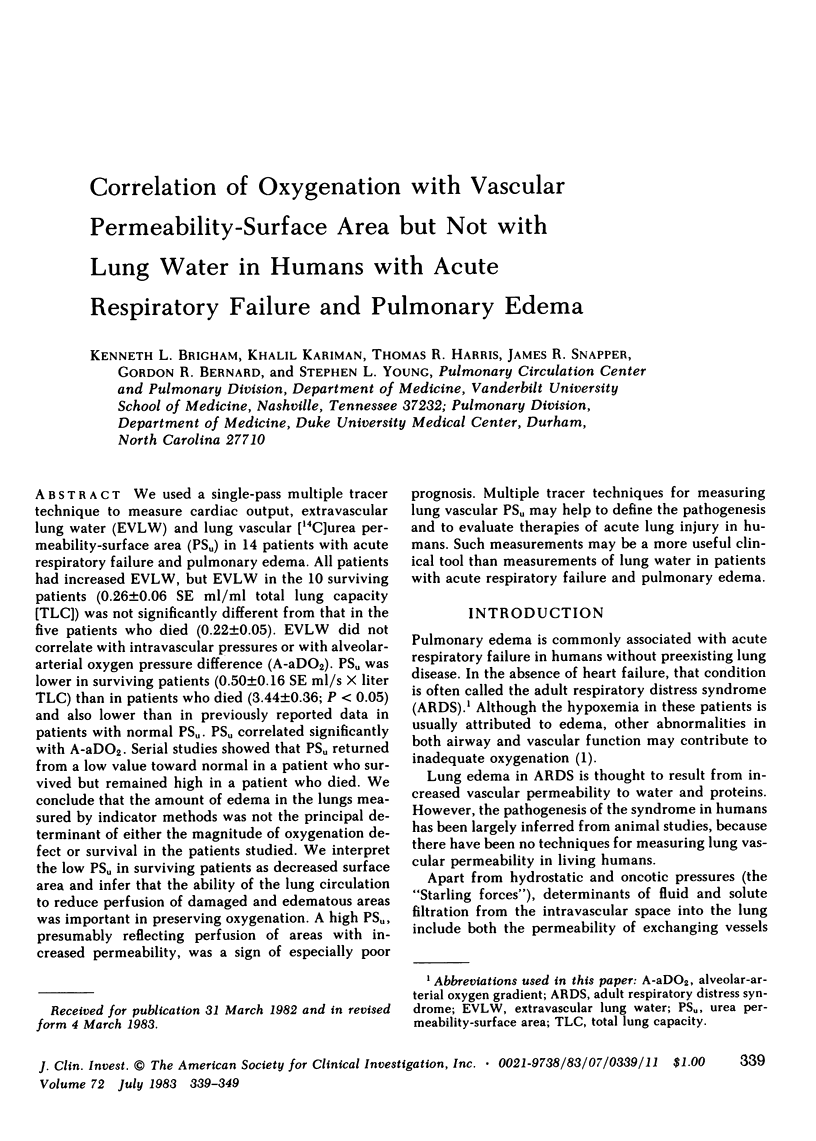
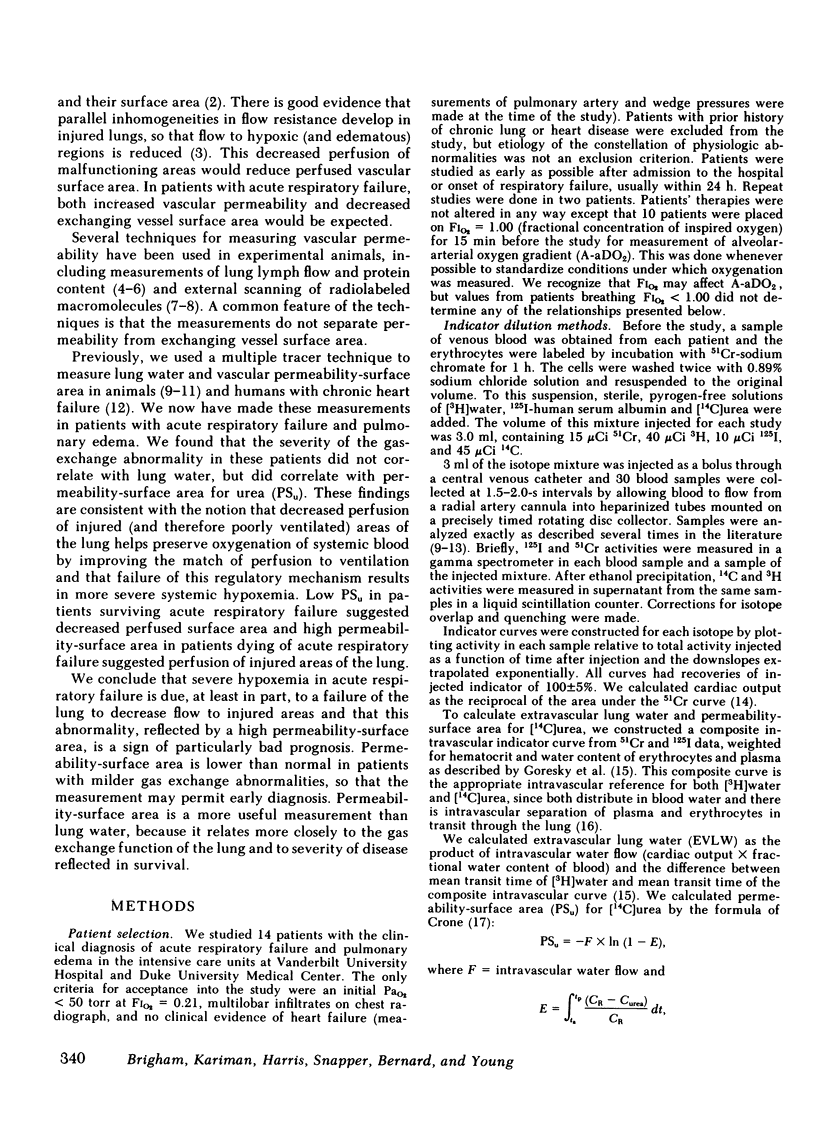
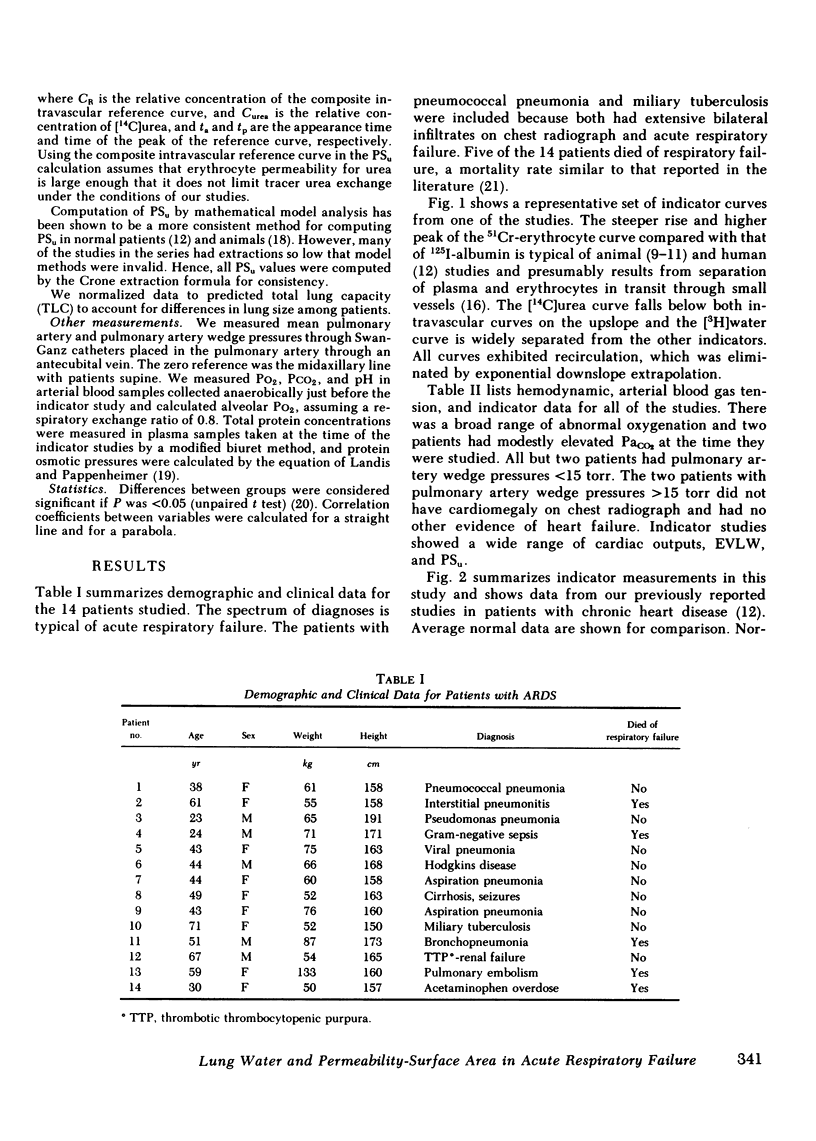
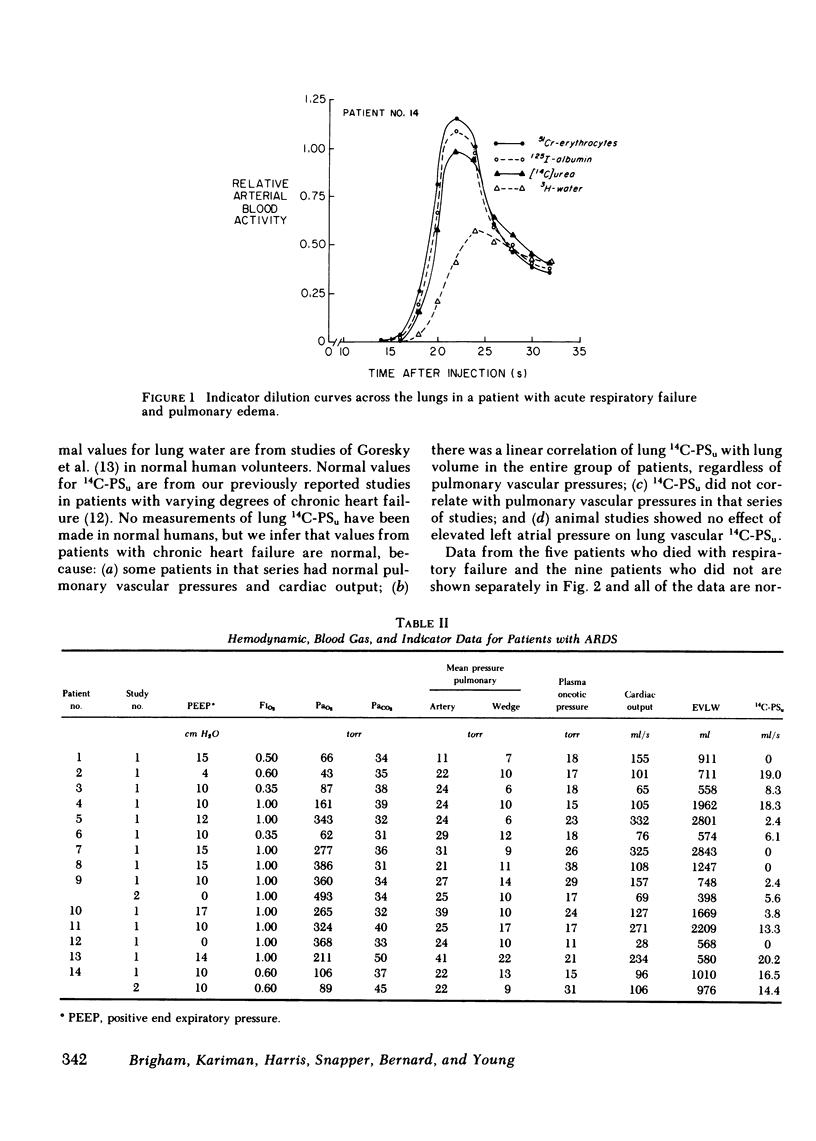
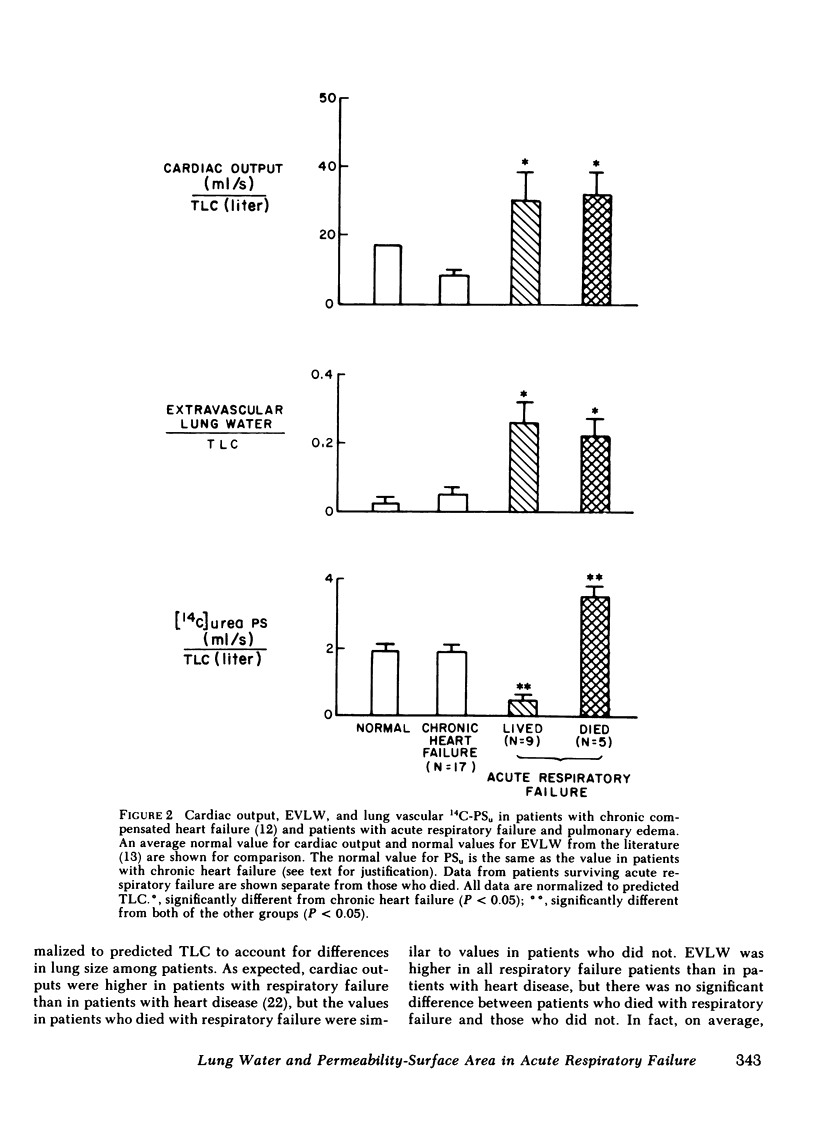
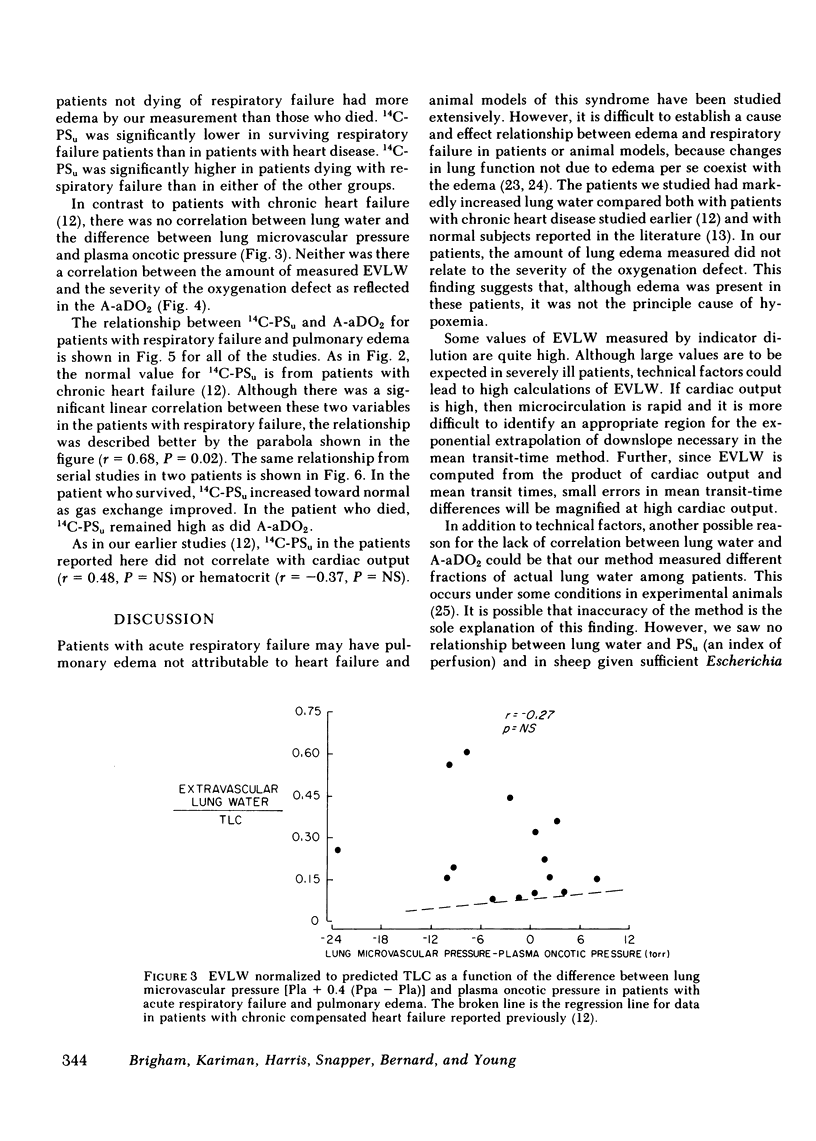
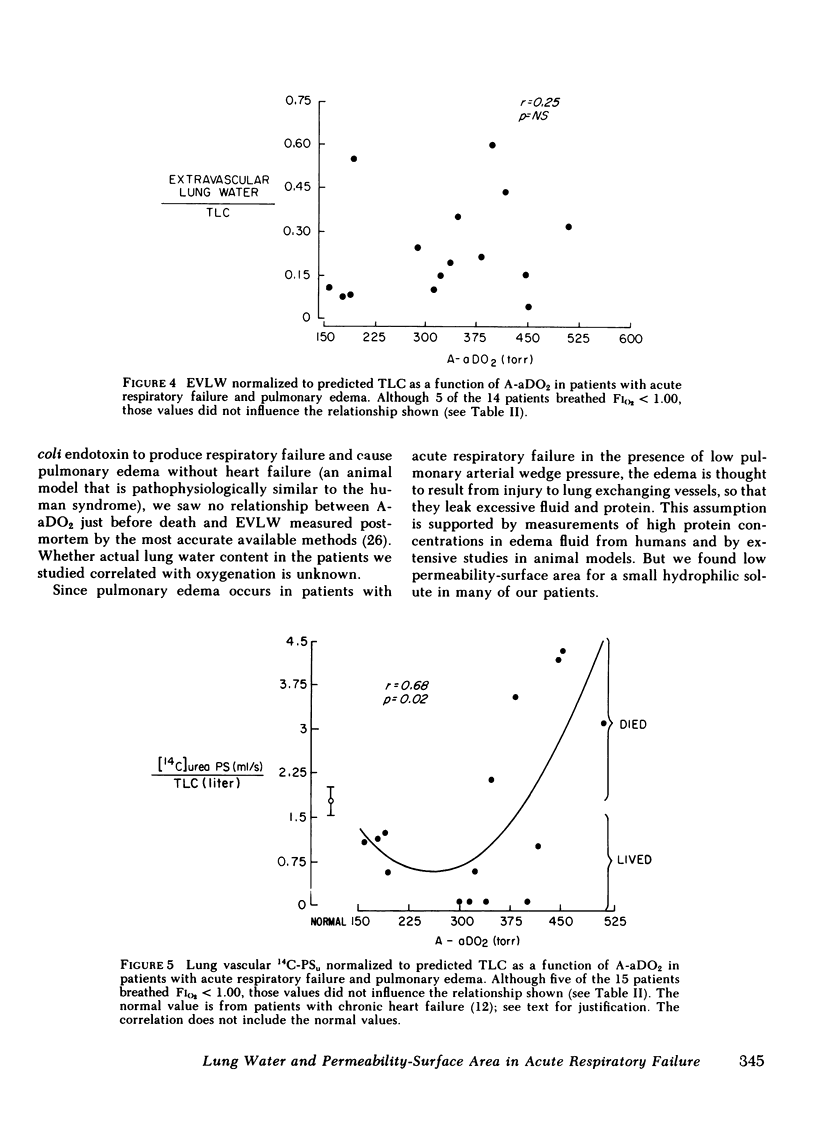
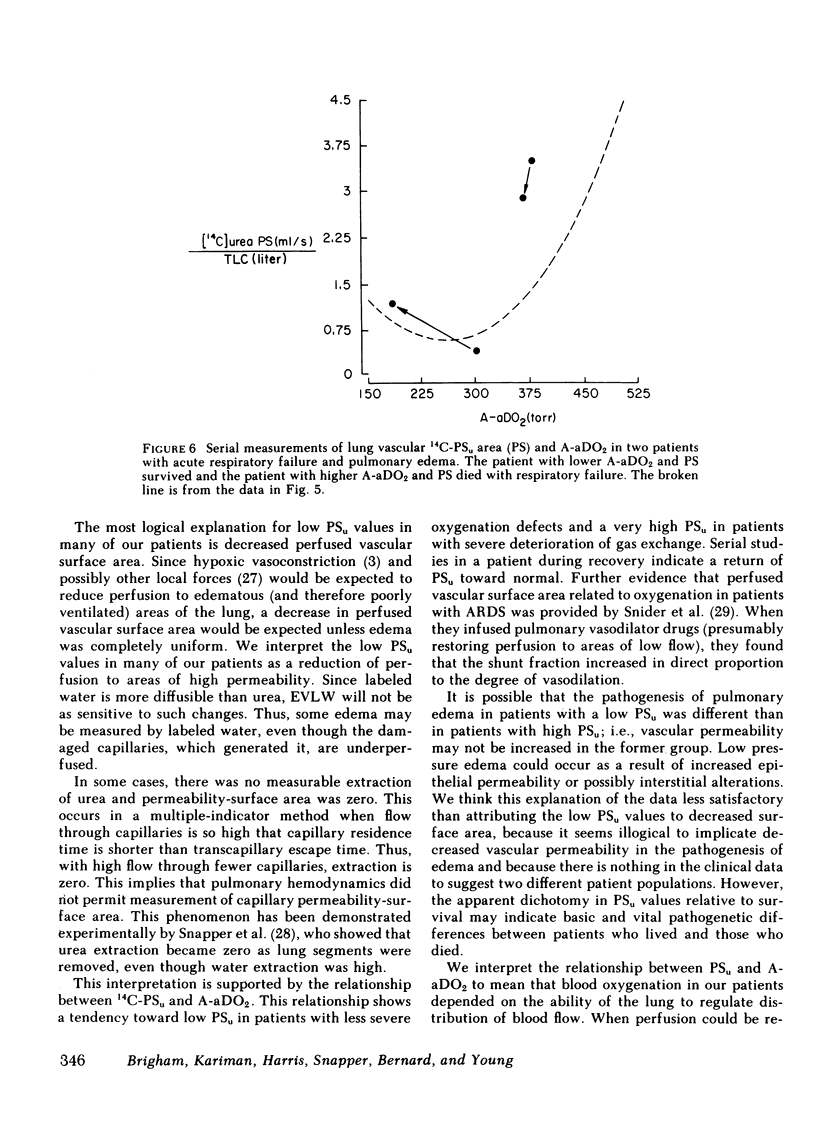
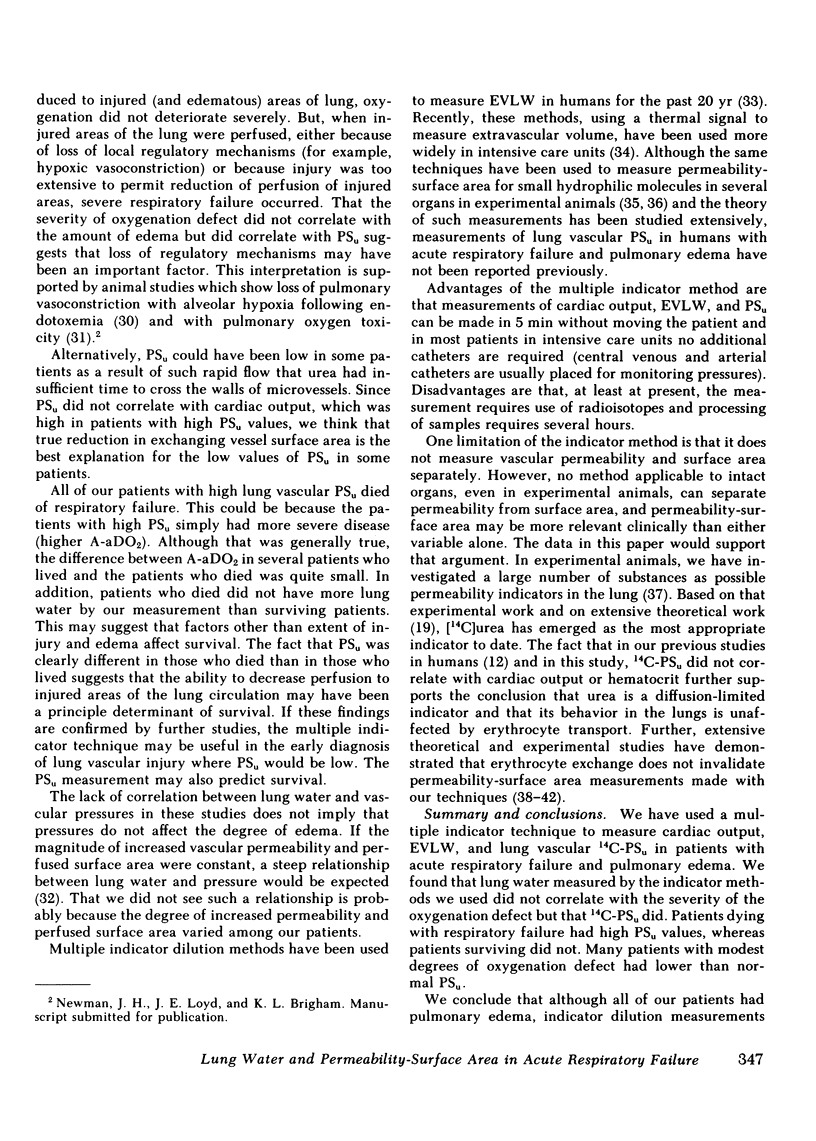
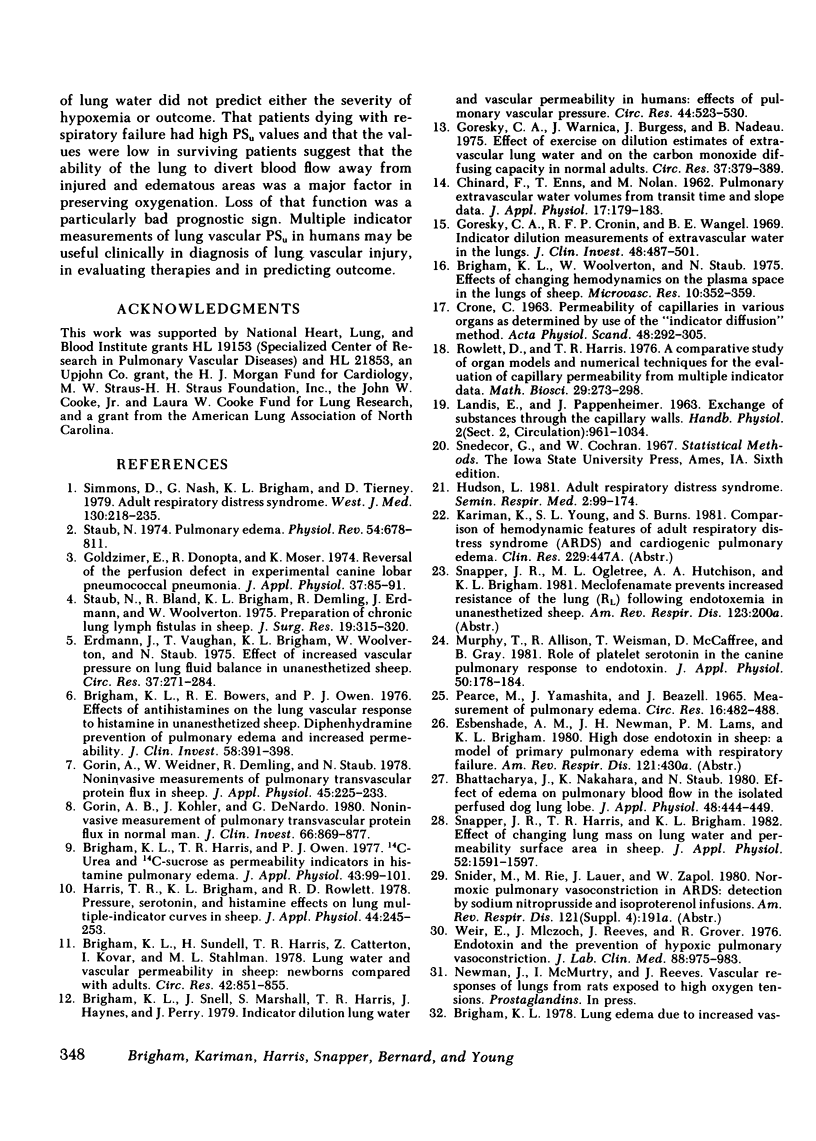
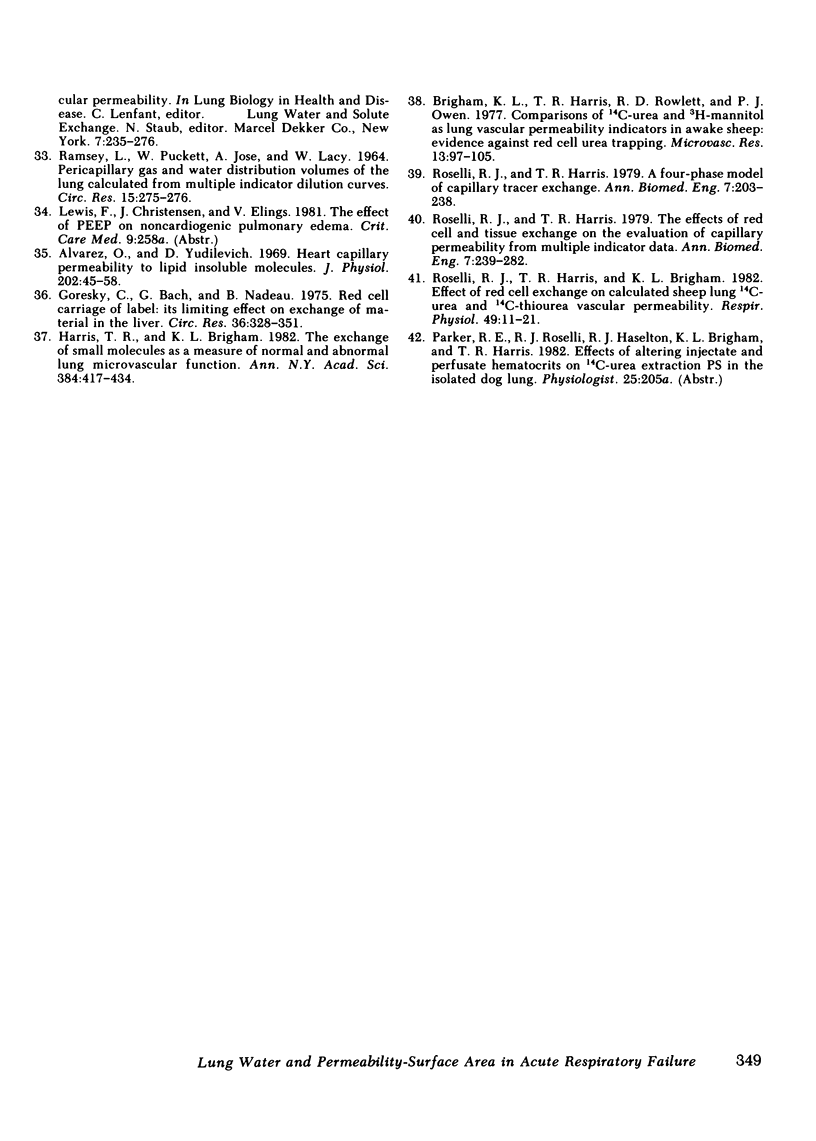
Selected References
These references are in PubMed. This may not be the complete list of references from this article.
- Alvarez O. A., Yudilevich D. L. Heart capillary permeability to lipid-insoluble molecules. J Physiol. 1969 May;202(1):45–58. doi: 10.1113/jphysiol.1969.sp008794. [DOI] [PMC free article] [PubMed] [Google Scholar]
- Bhattacharya J., Nakahara K., Staub N. C. Effect of edema on pulmonary blood flow in the isolated perfused dog lung lobe. J Appl Physiol Respir Environ Exerc Physiol. 1980 Mar;48(3):444–449. doi: 10.1152/jappl.1980.48.3.444. [DOI] [PubMed] [Google Scholar]
- Brigham K. L., Bowers R. E., Owen P. J. Effects of antihistamines on the lung vascular response to histamine in unanesthetized sheep. Diphenhydramine prevention of pulmonary edema and increased permeability. J Clin Invest. 1976 Aug;58(2):391–398. doi: 10.1172/JCI108483. [DOI] [PMC free article] [PubMed] [Google Scholar]
- Brigham K. L., Harris T. R., Owen P. J. [14C]urea and [14C]sucrose as permeability indicators in histamine pulmonary edema. J Appl Physiol Respir Environ Exerc Physiol. 1977 Jul;43(1):99–101. doi: 10.1152/jappl.1977.43.1.99. [DOI] [PubMed] [Google Scholar]
- Brigham K. L., Harris T. R., Rowlett R. D., Owen P. J. Comparisons of [14C]urea and [3H]mannitol as lung vascular permeability indicators in awake sheep: evidence against red cell urea trapping. Microvasc Res. 1977 Jan;13(1):97–105. doi: 10.1016/0026-2862(77)90118-2. [DOI] [PubMed] [Google Scholar]
- Brigham K. L., Snell J. D., Jr, Harris T. R., Marshall S., Haynes J., Bowers R. E., Perry J. Indicator dilution lung water and vascular permeability in humans. Effects of pulmonary vascular pressure. Circ Res. 1979 Apr;44(4):523–530. doi: 10.1161/01.res.44.4.523. [DOI] [PubMed] [Google Scholar]
- Brigham K. L., Sundell H., Harris T. R., Catterton Z., Kovar I., Stahlman M. Lung water and vascular permeability in sheep. Newborns compared with adults. Circ Res. 1978 Jun;42(6):851–855. doi: 10.1161/01.res.42.6.851. [DOI] [PubMed] [Google Scholar]
- Brigham K. L., Woolverton W. C., Staub N. C. Effects of changing hemodynamics on the extra plasma space in the lungs of sheep. Microvasc Res. 1975 Nov;10(3):352–359. doi: 10.1016/0026-2862(75)90038-2. [DOI] [PubMed] [Google Scholar]
- CRONE C. THE PERMEABILITY OF CAPILLARIES IN VARIOUS ORGANS AS DETERMINED BY USE OF THE 'INDICATOR DIFFUSION' METHOD. Acta Physiol Scand. 1963 Aug;58:292–305. doi: 10.1111/j.1748-1716.1963.tb02652.x. [DOI] [PubMed] [Google Scholar]
- Erdmann A. J., 3rd, Vaughan T. R., Jr, Brigham K. L., Woolverton W. C., Staub N. C. Effect of increased vascular pressure on lung fluid balance in unanesthetized sheep. Circ Res. 1975 Sep;37(3):271–284. doi: 10.1161/01.res.37.3.271. [DOI] [PubMed] [Google Scholar]
- Goldzimer E. L., Konopka R. G., Moser K. M. Reversal of the perfusion defect in experimental canine lobar pneumococcal pneumonia. J Appl Physiol. 1974 Jul;37(1):85–91. doi: 10.1152/jappl.1974.37.1.85. [DOI] [PubMed] [Google Scholar]
- Goresky C. A., Bach G. G., Nadeau B. E. Red cell carriage of label: its limiting effect on the exchange of materials in the liver. Circ Res. 1975 Feb;36(2):328–351. doi: 10.1161/01.res.36.2.328. [DOI] [PubMed] [Google Scholar]
- Goresky C. A., Cronin R. F., Wangel B. E. Indicator dilution measurements of extravascular water in the lungs. J Clin Invest. 1969 Mar;48(3):487–501. doi: 10.1172/JCI106006. [DOI] [PMC free article] [PubMed] [Google Scholar]
- Goresky C. A., Warnica J. W., Burgess J. H., Nadeau B. E. Effect of exercise on dilution estimates of extravascular lung water and on the carbon monoxide diffusing capacity in normal adults. Circ Res. 1975 Sep;37(3):379–389. doi: 10.1161/01.res.37.3.379. [DOI] [PubMed] [Google Scholar]
- Gorin A. B., Kohler J., DeNardo G. Noninvasive measurement of pulmonary transvascular protein flux in normal man. J Clin Invest. 1980 Nov;66(5):869–877. doi: 10.1172/JCI109953. [DOI] [PMC free article] [PubMed] [Google Scholar]
- Gorin A. B., Weidner W. J., Demling R. H., Staub N. C. Noninvasive measurement of pulmonary transvascular protein flux in sheep. J Appl Physiol Respir Environ Exerc Physiol. 1978 Aug;45(2):225–233. doi: 10.1152/jappl.1978.45.2.225. [DOI] [PubMed] [Google Scholar]
- Harris T. R., Brigham K. L., Rowlett R. D. Pressure, serotonin, and histamine effects on lung multiple-indicator curves in sheep. J Appl Physiol Respir Environ Exerc Physiol. 1978 Feb;44(2):245–253. doi: 10.1152/jappl.1978.44.2.245. [DOI] [PubMed] [Google Scholar]
- Harris T. R., Brigham K. L. The exchange of small molecules as a measure of normal and abnormal lung microvascular function. Ann N Y Acad Sci. 1982;384:417–434. doi: 10.1111/j.1749-6632.1982.tb21390.x. [DOI] [PubMed] [Google Scholar]
- Murphy T. L., Allison R. C., Weisman I. M., McCaffree D. R., Gray B. A. Role of platelet serotonin in the canine pulmonary response to endotoxin. J Appl Physiol Respir Environ Exerc Physiol. 1981 Jan;50(1):178–184. doi: 10.1152/jappl.1981.50.1.178. [DOI] [PubMed] [Google Scholar]
- PEARCE M. L., YAMASHITA J., BEAZELL J. MEASUREMENT OF PULMONARY EDEMA. Circ Res. 1965 May;16:482–488. doi: 10.1161/01.res.16.5.482. [DOI] [PubMed] [Google Scholar]
- RAMSEY L. H., PUCKETT W., JOSE A., LACY W. W. PERICAPILLARY GAS AND WATER DISTRIBUTION VOLUMES OF THE LUNG CALCULATED FROM MULTIPLE INDICATOR DILUTION CURVES. Circ Res. 1964 Oct;15:275–286. doi: 10.1161/01.res.15.4.275. [DOI] [PubMed] [Google Scholar]
- Roselli R. J., Harris T. R. A four phase model of capillary tracer exchange. Ann Biomed Eng. 1979;7(3-4):203–238. doi: 10.1007/BF02364115. [DOI] [PubMed] [Google Scholar]
- Roselli R. J., Harris T. R., Brigham K. L. Effects of red cell exchange on calculated sheep lung vascular permeability to 14C-urea and 14C-thiourea. Respir Physiol. 1982 Jul;49(1):11–21. doi: 10.1016/0034-5687(82)90100-1. [DOI] [PubMed] [Google Scholar]
- Roselli R. J., Harris T. R. The effects of red cell and tissue exchange on the evaluation of capillary permeability from multiple indicator data. Ann Biomed Eng. 1979;7(3-4):239–282. doi: 10.1007/BF02364116. [DOI] [PubMed] [Google Scholar]
- Simmons D. H., Nash G., Brigham K. L., Tierney D. F., Simmons D. H. Adult respiratory distress syndrome. West J Med. 1979 Mar;130(3):218–235. [PMC free article] [PubMed] [Google Scholar]
- Snapper J. R., Harris T. R., Brigham K. L. Effect of changing lung mass on lung water and permeability-surface area in sheep. J Appl Physiol Respir Environ Exerc Physiol. 1982 Jun;52(6):1591–1597. doi: 10.1152/jappl.1982.52.6.1591. [DOI] [PubMed] [Google Scholar]
- Staub N. C., Bland R. D., Brigham K. L., Demling R., Erdmann A. J., 3rd, Woolverton W. C. Preparation of chronic lung lymph fistulas in sheep. J Surg Res. 1975 Nov;19(5):315–320. doi: 10.1016/0022-4804(75)90056-6. [DOI] [PubMed] [Google Scholar]
- Staub N. C. Pulmonary edema. Physiol Rev. 1974 Jul;54(3):678–811. doi: 10.1152/physrev.1974.54.3.678. [DOI] [PubMed] [Google Scholar]
- Weir E. K., Mlczoch J., Reeves J. T., Grover R. F. Endotoxin and prevention of hypoxic pulmonary vasoconstriction. J Lab Clin Med. 1976 Dec;88(6):975–983. [PubMed] [Google Scholar]


